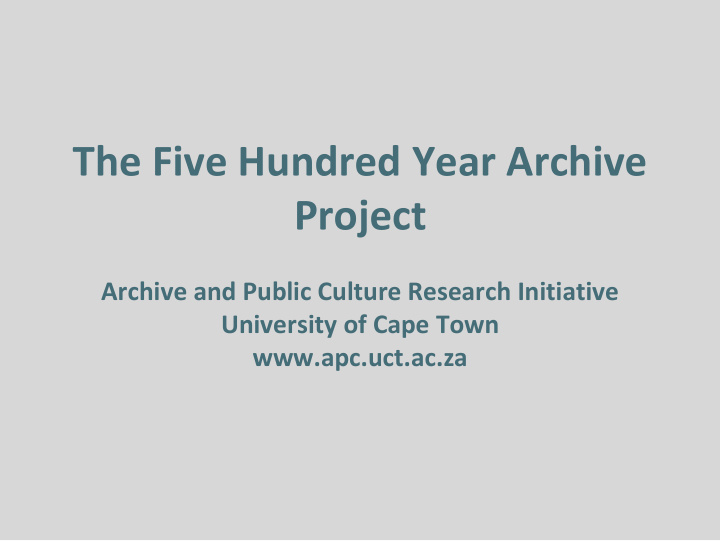



The Five Hundred Year Archive Project Archive and Public Culture Research Initiative University of Cape Town www.apc.uct.ac.za
Outline What is the FHYA Project? Why The Past Before Colonialism? Objectives of the FHYA What is the FHYA Exemplar? Challenges Potential of FHYA Model
Limited Scope Small region (initially southern Swaziland & KwaZulu-Natal) L imited time period (18th and 19th centuries)
Maximum Complexity Diverse institutions (archaeological repositories, libraries, art galleries, local and international) with their own practices and protocols D iverse mediums (sound recordings, texts, objects, botanical specimens, contemporary memory and practices) Diverse contributors (community and clan historians, professional historians, poets)
Why Past Before Colonialism: Under- researched & Archiveless? Dominance of the Written Record Resources exist in other non-textual forms Archival potential of material culture / oral recordings? Biased Knowledge Practices Our understanding of past before colonialism shaped by: Colonial and apartheid eras Materials about this past treated as ‘timeless, tribal and traditional’ Generic classifications and misidentification Scattered Materials Materials dispersed across the globe
Objectives of the FHYA Materials within & outside of archives Objects Archival Possibilities Sound recordings Provide example that could be replicated nationally / regionally Create a Model Enable enquiries into southern African past before colonialism Release materials from tribal and traditional classifications by focussing Release and Reconvene on provenance Materials Digitally reunite materials based on provenance
Archival Possibilities What is the FHYA? brass Objects from Ethnographic Collection Feasibility Study (KZNM ) Archaeological Past Before Colonialism: 500 years before the colonial era Remains (KZNM ) Initial Regional Focus: southern Swaziland & KwaZulu-Natal Objects Conceptual Intervention: Stems from critical enquiries into the past from JAG before colonialism, knowledge practices and classifications Textual references from Technical Intervention: Creation of digital model for particular region A.T. Br yant’ s Olden Times Izithakazelo (1 929) sound clip contributed by member of clan concerned
‘Male & Female Figures, Tsonga/ North Nguni, Natal’? Liberate materials by recovering information about PROVENANCE : Person who created item Under which conditions & for what purpose Reveal collection, classification and preservation processes Show that material has been subject to change over time
FHYA Exemplar - What? Assemble a Sample of Materials as Archive Show Expose FHYA Institutions as protocols Knowledge What does it Shapers do? Create Space Reveal for Further Change Over Addition of Time Materials
FHYA Exemplar - How? Locates Items Allows for Shows Current Additional Info Classification How does it do it? Restores Deconstructs Provenance Classification
Locates Items Item in Johannesburg Art Gallery Item generally not thought of as historical or archival material ‘Male & Female Figures, Tsonga/ North Nguni, Natal’?
Shows Current Classification
Deconstructs Classification
Restores Provenance
Allows for Additional Info
Challenges Digitisation in Southern Africa Issues with DISA Weakness of policy Lack of funding and capacity Institutions Anxieties about Digitisation Security of Physical Collection Intellectual Property Development Software Materials
Potential of FHYA Model Strengthen Understanding of archival potential of non-textual materials (such as physical objects and sound recordings) Connect Related Materials that are separately housed across institutions and include non-institutional materials Generate Inter-Institutional Dialogue and knowledge-sharing Stimulate interest in: Institutions’ collections through increased access and public engagement Past before colonialism as subject of research and study Facilitate In-Depth Research
Recommend
More recommend